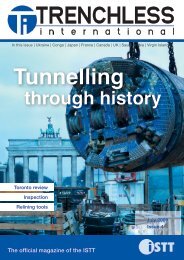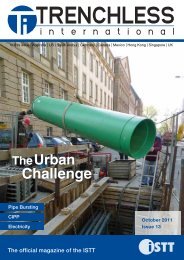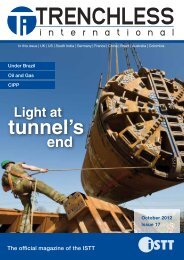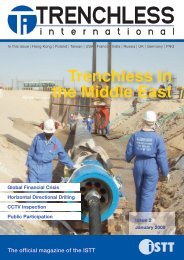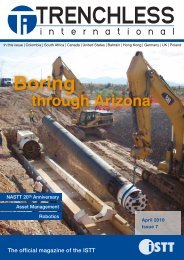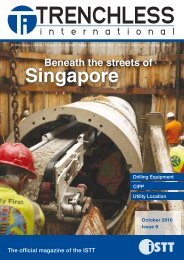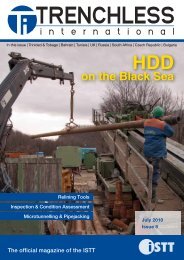North American Special - Trenchless International
North American Special - Trenchless International
North American Special - Trenchless International
You also want an ePaper? Increase the reach of your titles
YUMPU automatically turns print PDFs into web optimized ePapers that Google loves.
asset management<br />
April 2009 - <strong>Trenchless</strong> <strong>International</strong><br />
An example graph.<br />
but did not have sufficient failure history to<br />
warrant a standalone analysis.<br />
Sample results of the calibration process<br />
are shown in table 1. Results show a<br />
relatively long mean time to first failure for<br />
ductile iron pipes compared to cast iron<br />
pipes. However, for mean time to subsequent<br />
failures (especially after the 4th<br />
failure) cast iron pipes tend to outperform<br />
ductile iron. No significant differences<br />
were noticed in the performance of spun<br />
and pit cast iron pipes.<br />
The performance model was used to<br />
predict the following:<br />
• Long-term funding requirements for<br />
repair and replacement/rehabilitation<br />
under different level of service scenarios.<br />
Level of service was measured<br />
by number of failures experienced on a<br />
water main segment.<br />
• Using a Monte Carlo simulation to predict<br />
future failure patterns on various<br />
water main vintages, the optimum time<br />
to replace/rehabilitate was computed<br />
as a function of the ratio to repair<br />
to replacement cost. This minimum<br />
expected economic loss (MEEL) was<br />
found to be somewhat large for typical<br />
cost ratios (8-12 failures on a water<br />
main segment). This indicated that the<br />
governing criterion is more likely to be<br />
a level of service indicator set by the<br />
municipality rather than pure economics.<br />
In addition to the use of the model at the<br />
strategic planning level, the performance<br />
model was used to develop two important<br />
tools for water main management at the<br />
tactical/operational level. The coordinated<br />
infrastructure renewal tool and the early<br />
replacement tool set.<br />
Critical Water Main Management<br />
The approach for managing critical<br />
water mains differs considerably from that<br />
for noncritical mains. Some of these key<br />
differences include:<br />
• Repair policy: With noncritical water<br />
mains, breaks can be tolerated and<br />
hence a run-to-end of service life<br />
approach can be accepted. Conversely,<br />
critical water mains with zero tolerance<br />
for failure, a proactive maintenance and<br />
rehabilitation policy should be sought.<br />
• Tolerance to uncertainty: Whereas<br />
with noncritical water mains and their<br />
run to failure management approach<br />
uncertainty in condition state can be<br />
tolerated, no such tolerance can be<br />
allowed for critical water mains. This<br />
has ramifications on the amount of<br />
information being collected and the<br />
level of detail at which this information<br />
should be stored.<br />
The critical water main management<br />
framework consists of three main tool<br />
sets.<br />
1. Assessment rationalisation framework:<br />
2. Condition rating consolidation<br />
framework: This tool set attempts to<br />
standardise the way the results of<br />
assessment techniques are interpreted<br />
and subsequently used to drive decisions.<br />
The framework is developed<br />
for ductile iron and cast iron water<br />
mains as they compose the majority<br />
of the city’s critical inventory. The<br />
framework utilises Fuzzy Logic and<br />
the Analytical Hierarchy Process to<br />
combine condition rating results into an<br />
overall rating for the condition state as<br />
well as the expected deterioration rate<br />
of the pipe.<br />
3. Planning cycle decision analysis tool:<br />
The purpose of this tool is to equip<br />
the asset manager with a consistent<br />
methodology for decision-making<br />
during each planning cycle. Within<br />
a planning cycle, the asset manger<br />
must make one of three decisions<br />
for the critical water main inventory;<br />
schedule intervention, schedule<br />
inspection and revisit at next planning<br />
cycle.<br />
In order to make an informed decision,<br />
the asset manager must consider the following<br />
aspects:<br />
• Condition State. This is analogous to<br />
the probability of failure.<br />
• Pipeline Risk. This corresponds to the<br />
consequence of failure.<br />
• Extent of condition/deterioration<br />
information currently available. The<br />
tool performs a trade-off between<br />
the available amount of condition/<br />
deterioration information and the risk<br />
associated with operating the pipeline.<br />
• Level of uncertainty associated<br />
with inferring the condition state.<br />
Associated with the condition state<br />
that is inferred from the consolidation<br />
tool will be a measure of uncertainty.<br />
This factor must be considered in the<br />
decision process.<br />
This study is still ongoing and aims<br />
to re-evaluate what information is collected,<br />
and the way information is stored<br />
and handled throughout the lifecycle of<br />
the water main assets.<br />
Conclusion<br />
With these tools built, the city has established<br />
the foundation for the effective<br />
management of its watermain infrastructure.<br />
Furthermore, as these tools are<br />
integrated into the daily business decision<br />
process, they will be refined and<br />
improved to reflect the increasing knowledge<br />
growth within the city. They will also<br />
form the basis for clearly articulating the<br />
ramifications of decisions. This includes<br />
the need to focus resources, particularly<br />
financial, on the assessment of critical<br />
infrastructure, which in many cases has<br />
not yet failed or otherwise caused operational<br />
issues. These types of studies are<br />
often expensive and do not result in new<br />
tangible assets, but rather an improved<br />
understanding of the probability of failure.<br />
As such, these types of expenditures can<br />
often be challenging for cities and utilities<br />
to get funding approval for with out being<br />
able to demonstrate the non tangible<br />
benefits.<br />
This article is an edited version of a paper entitled Water Main Asset Management in the City of Hamilton: A Comprehensive Overview of Policies, Practices, Tools,<br />
and Technology by Hesham Osman and Kevin Bainbridge. The paper is to be presented at No-Dig 2009 Toronto, Canada. Please refer to the paper for more detailed<br />
information, references and acknowledgements.<br />
Delivering desalinated<br />
water to Sydney<br />
The $US419.5 million water delivery infrastructure project, part of<br />
the Sydney’s Desalination Project, aims to secure the city's water<br />
supply for future generations by constructing about 24 km of<br />
pipelines across Botany Bay, Australia.<br />
The new pipeline and its associated<br />
infrastructure and systems will carry the<br />
desalinated water from Kurnell, across<br />
Botany Bay, to Sydney's main water supply,<br />
the City Water Tunnel at Erskineville.<br />
Three tunnel boring machines (TBMs)<br />
will be employed to minimise the disturbance<br />
to residents and also to protect<br />
unique tracts of seagrass on the floor of<br />
Botany Bay.<br />
TBM: managing the environment<br />
The southern shore of Botany Bay contains<br />
extensive seagrass beds, which<br />
are a valued and protected part of the<br />
estuarine environment. Three species of<br />
seagrass are present off Silver Beach at<br />
Kurnell: zostera capricorni or eelgrass;<br />
posidonia australis or strapweed; and<br />
halophila ovalis or paddleweed. Posidonia<br />
requires the greatest consideration due to<br />
its slow reproduction and poor propagation<br />
by seed.<br />
Stretching about 6,500 metres in a westerly<br />
arc from Silver Beach at Kurnell to<br />
Lady Robinson’s Beach at Kyeemagh, the<br />
twin and single steel pipelines will impact<br />
approximately one per cent of the overall<br />
area of Botany Bay. Along the entire route,<br />
however, less than half of one per cent<br />
of existing seagrass along the southern<br />
shore (0.45 per cent) and Botany Bay<br />
(0.42 per cent) will be removed as a result<br />
of pipeline construction.<br />
Trenching through these seagrass beds<br />
would have required a seagrass management<br />
plan to be implemented during and<br />
after construction, and a compensatory<br />
seagrass package involving steps like<br />
transplantation. Instead, Sydney Water<br />
has chosen to microtunnel the pipeline<br />
from its Silver Beach construction area<br />
under Botany Bay for a distance of about<br />
800 metres in order to protect the seagrass.<br />
The Water Delivery Alliance will join<br />
the single 1,800 mm diameter pipeline<br />
from Silver Beach to the twin 1,400 mm<br />
diameter pipeline about 800 metres from<br />
the shoreline, and (as always) protection<br />
of the environment will be a key<br />
consideration. Pit construction is nearing<br />
completion at the Silver Beach site. This<br />
pit is supported by secant piling, has<br />
internal jet grouting and is around ten<br />
metres deep. Land-based sections of the<br />
pipeline will be constructed first. Material<br />
that has been dug up from the pit is being<br />
used on site where possible, in order to<br />
minimise truck movements. Continuous<br />
water quality monitoring is being carried<br />
out around the Silver Beach construction<br />
area. Recent monitoring of the site has<br />
indicated good water quality conditions,<br />
with similar results both inside and outside<br />
the silt curtain.<br />
TBM onshore<br />
A TBM is also an essential tool to minimise<br />
disruption onshore. The bore passes<br />
beneath Tasman and Dampier Streets,<br />
Kurnell, to install pipeline. The model<br />
shown is (page 45) a Herrenknecht earth<br />
pressure balance and AVN machine,<br />
weighing approximately 100 tonnes.<br />
The first microtunnelling drive through<br />
a residential area is now complete. The<br />
TBM tunnelled 640 metres from the<br />
launch pit in Cook Park, under General<br />
Holmes Drive and under Tancred Avenue<br />
to the receival pit at Muddy Creek. The<br />
TBM used was chosen specifically for the<br />
conditions at Cook Park. The pipe liner<br />
and services will be installed on this section<br />
of pipe in the coming months.<br />
The TBM has also finished tunnelling<br />
645 metres from Canal Road to<br />
Botany Freight Rail Line, which was the<br />
first tunnel completed on the project.<br />
Microtunnelling from Marsh Street<br />
Arncliffe, under the Cooks River to Tempe<br />
Recreation Reserve will begin in March.<br />
Choosing the route<br />
The pipeline route across Botany Bay<br />
was chosen because it avoids known<br />
areas of contamination. Every practical<br />
effort is being made to protect the<br />
Bay environment during construction.<br />
Water quality monitoring is ongoing<br />
during construction activities, in accordance<br />
with the Construction Water Quality<br />
Management Plan. The results of this<br />
monitoring will help the project team<br />
manage their work.<br />
environment<br />
April 2009 - <strong>Trenchless</strong> <strong>International</strong><br />
42<br />
43




